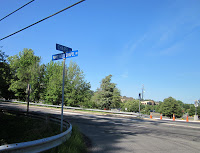 Northern Virginia Community College (NVCC) plans to install a traffic light at the intersection of Wakefield Chapel Road and Chapel Road is not sitting well with some local residents.
Northern Virginia Community College (NVCC) plans to install a traffic light at the intersection of Wakefield Chapel Road and Chapel Road is not sitting well with some local residents.
NVCC believes the signal would reduce traffic tie-ups in the neighborhood and allow people to get out of the NVCC parking lot faster, which would encourage more students to park in the lot rather than on neighborhood streets.
Mike Perel, a resident of Declaration Court, cites a number of adverse impacts of a traffic light at that location, including increased delays for people who drive through the area and increased cut-through traffic in the neighborhood by people trying to avoid the light. He urges community members to sign an online petition to stop the signal.
“I do not think many nearby residents know about the signal because NVCC has not had any widespread public notice about it,” he says.
At a regularly scheduled meeting in June to deal with Wakefield Chapel Road issues, Braddock Supervisor John Cook says he was surprised to learn that the traffic signal was a done deal, that NVCC was going to pay for it, and that work on it would start as early as July. “Nobody had been informed in advance,” Cook says.
According to Katherine Stramel, community outreach specialist for NVCC’s Annandale campus, VDOT conducted a study and “found that the intersection warranted a signal.” Because funds were unavailable from the county, NVCC is installing and paying for the signal, she says, and VDOT will approve the timing of the light.
Stramel says the college had “discussed the traffic signal at several community meetings” and is working with Del. Vivian Watts and Cook “to identify local residents to participate on a community working group regarding specific issues with the light.” She says a date for installing the signal has not been set.
Normally, when VDOT proposes a traffic signal or other road improvement, “VDOT consults with the county, and it’s a joint effort,” Cook says. But since NVCC is a state institution, “it doesn’t have to comply with county rules.” And that, Cook says, is one reason why he had made the need for the county to take control of the roads a key issue in his re-election campaign.
Cook says NVCC has agreed to incorporate some proposals from community members for improving traffic flow, including creating a turning lane for drivers heading into the NVCC parking lot; a concrete slab, known as a “porkchop,” in the median to prevent people on Chapel Road from going straight into the lot; and lane striping at Briar Creek Drive so people don’t block that intersection.
He said the porkchop would prevent people on Little River Turnpike from turning onto Chapel Road to avoid the traffic signal on Wakefield Chapel, and thus prevent cut-through traffic in the neighborhood.
Peral says any tweaks to the design of the traffic signal “do not address the need for the light versus alternatives that could be safer and have less negative effects.” He warns that the signal would create even worse problems than it is intended so solve.
“VDOT literature, other research, and even the traffic engineer at the June 13 meeting said that traffic signals will at best not reduce crashes, but will change the type of crashes,” Perel says. “If NVCC was really concerned about student safety, they would lower the parking fees so that students will not park on neighborhood streets and expose themselves to the pedestrian risk of crossing the street,” he says. And if exiting quicker was the main goal, he suggests investigating “a modern roundabout” as an alternative to a signal.
He also questions NVCC’s assertion that the college can install a traffic light without notifying local residents. “That blows my mind,” he says. “When I built a carport, I had to notify my neighbors.”
 Northern Virginia Community College (NVCC) plans to install a traffic light at the intersection of Wakefield Chapel Road and Chapel Road is not sitting well with some local residents.
Northern Virginia Community College (NVCC) plans to install a traffic light at the intersection of Wakefield Chapel Road and Chapel Road is not sitting well with some local residents.
